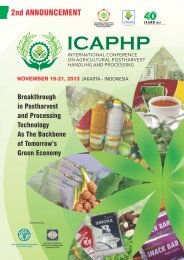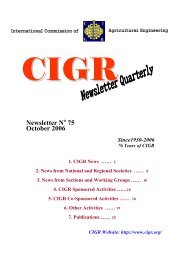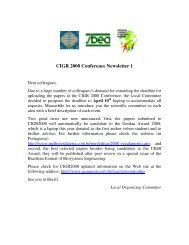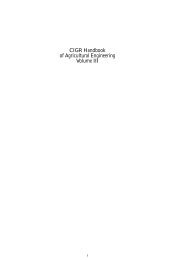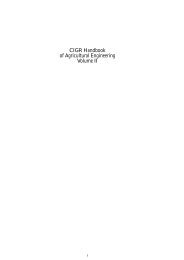- Page 2 and 3: TABLE OF CONTENTS GENERAL INFORMATI
- Page 4 and 5: LIST OF ABSTRACTS BY PARTICIPATING
- Page 6 and 7: LIST OF ABSTRACTS BY PARTICIPATING
- Page 8 and 9: LIST OF ABSTRACTS BY PARTICIPATING
- Page 10 and 11: LIST OF ABSTRACTS BY PARTICIPATING
- Page 12 and 13: LIST OF ABSTRACTS BY PARTICIPATING
- Page 14 and 15: LIST OF ABSTRACTS BY PARTICIPATING
- Page 16 and 17: LIST OF ABSTRACTS BY PARTICIPATING
- Page 18 and 19: LIST OF ABSTRACTS BY PARTICIPATING
- Page 20 and 21: LIST OF ABSTRACTS BY PARTICIPATING
- Page 22 and 23: LIST OF ABSTRACTS BY PARTICIPATING
- Page 24 and 25: LIST OF ABSTRACTS BY PARTICIPATING
- Page 26 and 27: LIST OF ABSTRACTS BY PARTICIPATING
- Page 28 and 29: DRAINAGE OF IRRIGATED LANDS C. B. D
- Page 30 and 31: DEVELOPMENT OF MODEL EQUATIONS FOR
- Page 32 and 33: LIQUID DISTRIBUTION OF AIR INDUCTIO
- Page 34 and 35: MODELLING PHOSPHORUS INPUTS FROM DI
- Page 36 and 37: COMPARISON OF DRAINMOD AND ARTIFICI
- Page 38 and 39: THE EFFECTS OF TREATED WASTEWATER O
- Page 40 and 41: ENVIRONMENTAL AND ECONOMIC MULTI-OB
- Page 42 and 43: PERFORMANCE OF BIODRAINAGE SYSTEMS
- Page 44 and 45: ESTIMATING RECLAMATION WATER REQUIR
- Page 46 and 47: IMPACT OF CLIMATE CHANGE ON DRAINAG
- Page 48 and 49: GROUND WATER RECHARGE IN WAGARWADI
- Page 52 and 53: TEMPERATURE EFFECTS ON SHALLOW WATE
- Page 54 and 55: USE OF AGRICULTURAL CENSUS DATA FOR
- Page 56 and 57: FIELD EVALUATIONS OF A FORESTRY VER
- Page 58 and 59: EVALUATION OF DRAINMOD IN PREDICTIN
- Page 60 and 61: PREDICTED IMPACTS OF CLIMATE CHANGE
- Page 62 and 63: EFFECT OF WATER STRESS ON YIELD AND
- Page 64 and 65: MATHEMATICAL MODELLING ON THE OPERA
- Page 66 and 67: EFFECTS OF DRAIN DEPTH ON NITRATE-N
- Page 68 and 69: MINNESOTA AGRICULTURAL DITCH REACH
- Page 70 and 71: INFLUENTIAL PARAMETERS FOR DESIGNIN
- Page 72 and 73: PRELIMINARY STUDY OF THE WRSIS CONC
- Page 74 and 75: DEFICIT IRRIGATION AS AN AGRICULTUR
- Page 76 and 77: A COMPARISON OF MIKE SHE AND DRAINM
- Page 78 and 79: DEVELOPMENT OF A SYSTEM FOR PATTERN
- Page 80 and 81: LASER LIGHT BACKSCATTERING FOR MONI
- Page 82 and 83: SPOT-APPLICATION OF PESTICIDE USING
- Page 84 and 85: THE IMPORTANCE OF FISH NEUROHORMONA
- Page 86 and 87: DEVELOPMENT OF CRITERIA AND INDICAT
- Page 88 and 89: DEVELOPMENT OF A MODEL FOR ESTIMATI
- Page 90 and 91: FIELD EVALUATION AND COMPARISON OF
- Page 92 and 93: GEOGRAPHICAL SHIFT IN LIVESTOCK PRO
- Page 94 and 95: THE DESIGN OF REPLACEMENT HEIFERS A
- Page 96 and 97: COMPARISON OF DIFFERENT PLANTATION
- Page 98 and 99: ENERGY CONSUMPTION AND COMMERCIAL A
- Page 100 and 101:
GAIT AND FORCE ANALYSIS OF PROVOKED
- Page 102 and 103:
PERFORMANCE SIMULATION OF HIGH VOLU
- Page 104 and 105:
ENERGY USAGE FOR COTTON GINNING IN
- Page 106 and 107:
REDUCING AMMONIA RELEASE IN A FLOOR
- Page 108 and 109:
ESTIMATION OF TOMATO NUTRITIONAL ST
- Page 110 and 111:
A REVIEW OF STANDARDS RELATED TO BI
- Page 112 and 113:
PULSED ELECTRIC FIELDS AND MICROFIL
- Page 114 and 115:
A CRITICAL EVALUATION OF THE ACCURA
- Page 116 and 117:
TECHNICAL APPROACH FOR ROW CROP SEE
- Page 118 and 119:
ADVANCED WEB OUTREACH TECHNIQUES: C
- Page 120 and 121:
THERMAL CHARACTERISTICS OF GELATIN
- Page 122 and 123:
MEASUREMENT OF DILATION OF ROOT CRO
- Page 124 and 125:
INFLUENCE OF COOLING SYSTEMS ON THE
- Page 126 and 127:
TILLAGE EFFECTS ON SOIL AND PRODUCT
- Page 128 and 129:
INTEGRATED WATER SUPPLY MANAGEMENT
- Page 130 and 131:
ENGINEERING DEVELOPMENTS FOR SMALL-
- Page 132 and 133:
SOIL FAILURE MODE IN FRONT OF A MUL
- Page 134 and 135:
GRID BASED RAINFALL-RUNOFF GIS MODE
- Page 136 and 137:
AMMONIA AND CARBON DIOXIDE EMISSION
- Page 138 and 139:
STRESS RELAXATION BEHAVIOUR OF A HI
- Page 140 and 141:
INVESTIGATING THE POTENTIAL FOR RIC
- Page 142 and 143:
ADVANCES OF RESEARCH ON STRUCTURAL
- Page 144 and 145:
A SIMPLE METHOD FOR MEASUREMENT OF
- Page 146 and 147:
ANALYSIS OF THE MOVEMENT OF FRUITS
- Page 148 and 149:
SOIL BIN INVESTIGATIONS OF THE EFFE
- Page 150 and 151:
MODELING AND STATISTICAL CHARACTERI
- Page 152 and 153:
SOIL BIOENGINEERING TECNIQUES IN FL
- Page 154 and 155:
A UNIFIED PEST SCOUTING FOR AREA-WI
- Page 156 and 157:
USE OF FARM WASTE BIOMASS IN THE PR
- Page 158 and 159:
DETECTION OF INTERNAL DEFECT IN PIC
- Page 160 and 161:
OPTIMIZATION AND CONTROL OF A NOVEL
- Page 162 and 163:
SHRINKAGE EFFECT ON MOISTURE DIFFUS
- Page 164 and 165:
THE EFFECT OF FAN FREQUENCY ON THE
- Page 166 and 167:
MODELLING THE GROUNDWATER DYNAMICS
- Page 168 and 169:
USING PLANT MACROMOLECULES TO PRODU
- Page 170 and 171:
CROP ROWS TRACKING BY DETECTING IND
- Page 172 and 173:
RHEOLOGICAL CHARACTERISTICS OF ASSA
- Page 174 and 175:
IRRIGATION MANAGEMENT IN REAL TIME
- Page 176 and 177:
MAPPING OF SOIL SALINITY AND CLAY C
- Page 178 and 179:
A META-ANALYSIS OF WEATHER EFFECTS
- Page 180 and 181:
EVALUATION OF NOVEL HIGH INTENSITY
- Page 182 and 183:
AGRICULTURAL FLEET MANAGEMENT: A SY
- Page 184 and 185:
MEASUREMENTS OF AIR VENTILATION RAT
- Page 186 and 187:
THEORETICAL ANALYSIS OF ENERGY REQU
- Page 188 and 189:
DETERMINATION OF PRESSURE DISTRIBUT
- Page 190 and 191:
MODELING OF ROUGH RICE DRYING KINET
- Page 192 and 193:
COMPARISON OF CLEANING PERFORMANCE
- Page 194 and 195:
DESIGN AND DEVELOPMENT OF A CUTTER
- Page 196 and 197:
QUANTITATIVE ASSESSMENT OF MAPLE SY
- Page 198 and 199:
COMPARISON OF DIFFERENT METHODS FOR
- Page 200 and 201:
AGAVE JUICE AS AN AGENT FOR PROBIOT
- Page 202 and 203:
THERMAL ENVIRONMENT INSIDE BROILER
- Page 204 and 205:
INFLUENCE OF POLYGLYCEROL ESTERS OF
- Page 206 and 207:
NUMERICAL INVESTIGATION OF A BUBBLE
- Page 208 and 209:
AERODYNAMIC ANALYSIS OF AIR POLLUTA
- Page 210 and 211:
DEVELOPMENT OF A WATER CATCHER FOR
- Page 212 and 213:
AGRICULTURAL FLEET MANAGEMENT: AN O
- Page 214 and 215:
AUTOMATED MONITORING OF VARIATIONS
- Page 216 and 217:
CORPORATE HARVEST OF GRASS SILAGE -
- Page 218 and 219:
AUTOMATIC GRADING OF ANTHURIUM CUT
- Page 220 and 221:
GREENHOUSE GAS MITIGATION POTENTIAL
- Page 222 and 223:
AN APPROACH FOR PESTICIDE LOSS ESTI
- Page 224 and 225:
ANALYSIS AND ASSESSMENT OF WORKLOAD
- Page 226 and 227:
MILKING TECHNOLOGY ON MODERN DAIRY
- Page 228 and 229:
EFFECTS OF THE CROP ROOT ON THE SOI
- Page 230 and 231:
REDUCING FRICTION BY ULTRASONIC VIB
- Page 232 and 233:
USING PRE-HEATED SUNFLOWER OIL AS F
- Page 234 and 235:
EXPERIENCES ON THE INTEGRATION OF T
- Page 236 and 237:
MODELLING BAFFLES IN WATER ACQUACUL
- Page 238 and 239:
COMPARISON OF TRACTOR-ROTARY TILLER
- Page 240 and 241:
AMMONIA EMISSIONS FROM BROILER HOUS
- Page 242 and 243:
EVALUATION OF CHIPS QUALITY BY THE
- Page 244 and 245:
THIN LAYER DRYING OF SLICED SQUASH
- Page 246 and 247:
DESIGN AND EVALUATION OF A JAB PLAN
- Page 248 and 249:
DESIGN AND EVALUATION OF AN AUTOMAT
- Page 250 and 251:
PREDICTION OF LACTIC-BACTERIA GROWT
- Page 252 and 253:
A FARM SYSTEM APPROACH TO ANALYZE G
- Page 254 and 255:
A DEVICE FOR EXTRACTING 3D INFORMAT
- Page 256 and 257:
AERODYNAMIC PROPERTIES OF HEMP FIBR
- Page 258 and 259:
MODELLING THE STRESS RESPONSES OF L
- Page 260 and 261:
EFFECTS OF AIR EXCHANGE, TEMPERATUR
- Page 262 and 263:
EFFECTS OF MECHANICAL AERATION ON T
- Page 264 and 265:
MECHANICAL CONTROL OF QUACKGRASS IN
- Page 266 and 267:
ANAEROBIC DIGESTION AND RELATED BES
- Page 268 and 269:
CONTROLLED TRAFFIC FARMING AND MINI
- Page 270 and 271:
PREDICTION OF PROCESS AND PRODUCT P
- Page 272 and 273:
TEXTURE EVALUATION AFFECTED BY PHYS
- Page 274 and 275:
PATHOGEN REMOVAL FROM PIG MANURE BY
- Page 276 and 277:
FACTORS INFLUENCING FORMATION AND S
- Page 278 and 279:
MEASURING CONCEPT FOR DETERMINING A
- Page 280 and 281:
ASSESSING ODOUR PLUMES SURROUNDING
- Page 282 and 283:
DETERMINATION OF FORWARD SPEED EFFE
- Page 284 and 285:
USE OF HYPERSPECTRAL IMAGING FOR TH
- Page 286 and 287:
RU-SLIMS DEVELOPMENT OF RUTGERS UNI
- Page 288 and 289:
AMMONIA REDUCTION AND MAINTENANCE C
- Page 290 and 291:
ADVANCED TECHNOLOGIES APPLIED TO HO
- Page 292 and 293:
INFLUENCE OF HUMMOCKS AND EMERGENT
- Page 294 and 295:
EFFICIENCY OF THE HEAT PUMP COOPERA
- Page 296 and 297:
MACHINE LEARNING MODELS FOR PREDICT
- Page 298 and 299:
TOWARDS A FRAMEWORK FOR PLANNING AN
- Page 300 and 301:
EFFECT OF ADDITION OF DIFFERENT TYP
- Page 302 and 303:
USE OF A NOVEL IN-PACKAGE OZONATION
- Page 304 and 305:
SUSTAINABILTY OF RICE PROCESSING IN
- Page 306 and 307:
EFFECT OF NONIONIC SURFACTANT BRIJ
- Page 308 and 309:
DESIGN CHALLENGES TO THE INTEGRATIO
- Page 310 and 311:
EFFECTS OF MICROWAVE DRYING AND COO
- Page 312 and 313:
THE ROLE OF THE WEB IN THE EFFECTIV
- Page 314 and 315:
REDUCING ODOUR AND AMMONIA EMISSION
- Page 316 and 317:
INFLUENCE OF INSECT NETS AND THERMA
- Page 318 and 319:
CULTIVATION AND UTILIZATION OF SPEC
- Page 320 and 321:
EFFECT OF MICROWAVE RADIATION ON ST
- Page 322 and 323:
ADSORPTIVE REMOVAL OF PHOSPHATE ANI
- Page 324 and 325:
MODELLING AND SIMULATION OF PROCESS
- Page 326 and 327:
MEASUREMENT OF AMMONIA EMISSIONS FR
- Page 328 and 329:
EXPERIMENTAL STUDY OF BANANA DRYING
- Page 330 and 331:
A TRIPLE-SENSOR HORIZONTAL PENETROM
- Page 332 and 333:
MODELING OF SOIL FLOW FOR TILLAGE T
- Page 334 and 335:
A FULLY INTEGRATED MARINE ENVIRONME
- Page 336 and 337:
A NOVEL SINGLE-STEP ROUTE BASED ON
- Page 338 and 339:
EMPTY DRAIN AND THE WATER LEVEL AT
- Page 340 and 341:
MIGRATION OF PERFLUORINATED COMPOUN
- Page 342 and 343:
SPATIAL AND TEMPORAL VARIATION IN T
- Page 344 and 345:
IMPACT OF TEMPERATURE CONTROL STRAT
- Page 346 and 347:
IMPROVEMENT OF NUTRITIONAL BENEFITS
- Page 348 and 349:
REDUCTION OF ODOUR EMISSIONS FROM S
- Page 350 and 351:
VELOCITY OF CONVEYED SEEDS IN AN IN
- Page 352 and 353:
A VARIABLE RATE GRAIN DRILL FOR PLA
- Page 354 and 355:
THE DEVELOPMENT OF PROCESS MECHANIZ
- Page 356 and 357:
CONCEPTUAL MODELING FOR THE DESIGN
- Page 358 and 359:
COLOR TEXTURE FEATURE ANALYSIS FOR
- Page 360 and 361:
GRADE CLASSIFICATION AND PROTEIN CO
- Page 362 and 363:
REMOTE SENSING AND GIS FOR RURAL/UR
- Page 364 and 365:
CLAW AND FOOT HEALTH: EARLY DIAGNOS
- Page 366 and 367:
AUTOMATIC AND FREQUENCY-PROGRAMMABL
- Page 368 and 369:
PREDICTING VENTILATION RATES IN HYB
- Page 370 and 371:
IDENTIFICATION OF KEY ODOUR COMPONE
- Page 372 and 373:
SAD-RH: A GENERIC DECISION SUPPORT
- Page 374 and 375:
ANTIBACTERIAL ACTIVITIES OF NANO-CR
- Page 376 and 377:
MODELING CITY TREE GROWTH WITH ARTI
- Page 378 and 379:
CONTINUOUS FERMENTATIVE HYDROGEN PR
- Page 380 and 381:
TRANSFORMING ANAEROBIC DIGESTION WI
- Page 382 and 383:
WATER USE AND SUSTAINABILITY IN GLO
- Page 384 and 385:
GAS PRODUCTION ANALYSIS OF A FIXED-
- Page 386 and 387:
PATTERNS IN GROUNDWATER HYDROLOGY O
- Page 388 and 389:
USING USGS NAWQA AND EPA WSA DATA T
- Page 390 and 391:
DECISION SUPPORT SYSTEMS FOR ENVIRO
- Page 392 and 393:
INVESTIGATION OF SHELLED CORN DRYIN
- Page 394 and 395:
A MULTI-LINGUAL TRANSLATION ENGINE
- Page 396 and 397:
CHALLENGES IN ECOLOGICAL NICHE MODE
- Page 398 and 399:
INTEGRATION OF PV MODULES IN EXISTI
- Page 400 and 401:
DRAINAGE CONTROL SYSTEMS (DCS) VINC
- Page 402 and 403:
402 XVII th World Congress of the I



